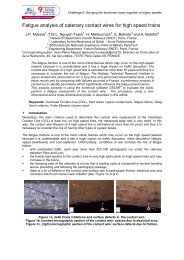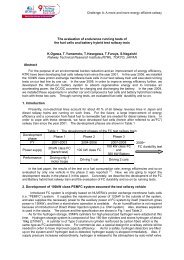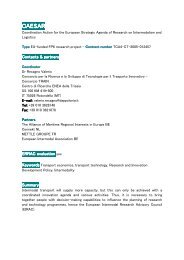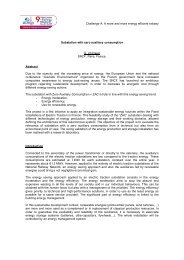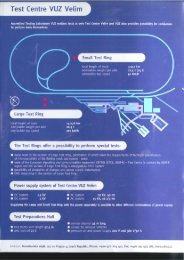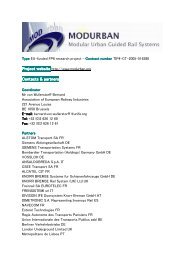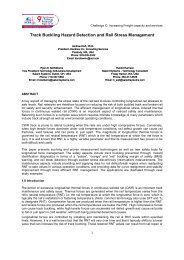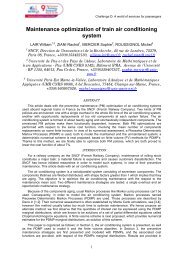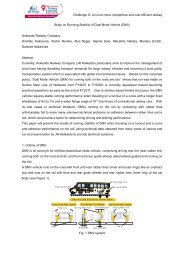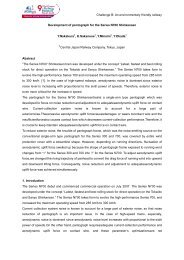Transients in railway environments; Measurements & Modelling ...
Transients in railway environments; Measurements & Modelling ...
Transients in railway environments; Measurements & Modelling ...
You also want an ePaper? Increase the reach of your titles
YUMPU automatically turns print PDFs into web optimized ePapers that Google loves.
<strong>Transients</strong> <strong>in</strong> <strong>railway</strong> <strong>environments</strong>; <strong>Measurements</strong> & Modell<strong>in</strong>g<br />
Authors<br />
Frans Schoren, BIT TIPS, S<strong>in</strong>gapore<br />
Erw<strong>in</strong> Smulders, Holland Railconsult, The Netherlands<br />
Gert-Jan van Alphen, Holland Railconsult, The Netherlands<br />
Kees Post, Lambda Eng<strong>in</strong>eer<strong>in</strong>g BV, The Netherlands<br />
Contact address:<br />
Holland Railconsult, PO Box 2855, 3500 GW Utrecht, The Netherlands<br />
Subject<br />
The measurements of transients magnetic fields generated by <strong>railway</strong> systems,<br />
comb<strong>in</strong>ed with modell<strong>in</strong>g, both <strong>in</strong> the time doma<strong>in</strong> as well as <strong>in</strong> the frequency<br />
doma<strong>in</strong>.<br />
Abstract<br />
Especially <strong>in</strong> densely populated areas, such as the Netherlands, there is a grow<strong>in</strong>g<br />
demand to <strong>in</strong>tegrate <strong>railway</strong> systems with other <strong>in</strong>frastructure. A well-balanced EMC<br />
approach is becom<strong>in</strong>g more and more important. On one side “possible victims” are<br />
becom<strong>in</strong>g more susceptible with the <strong>in</strong>crease <strong>in</strong> the bandwidths and frequencies used.<br />
On the other side, the emission of <strong>railway</strong> systems can <strong>in</strong>crease with the<br />
implementation of high-speed l<strong>in</strong>es. The need to reach compatibility between the<br />
<strong>railway</strong> system and other electrotechnical systems, both <strong>railway</strong> related as well as<br />
those of third parties is paramount. The prediction of the susceptibility of the<br />
„victims“ is not easy, but can be accomplished, us<strong>in</strong>g the relevant immunity standards<br />
and measurements. It is more complicated to predict the maximum emission of a<br />
<strong>railway</strong> system as a whole.<br />
For the design of ground<strong>in</strong>g systems <strong>in</strong> <strong>railway</strong>s, 50 Hz considerations play a major<br />
role. These 50 Hz current distributions and correspond<strong>in</strong>g voltages are reasonably<br />
well understood and modell<strong>in</strong>g tools are available. However, part of the EMC<br />
considerations concern higher frequencies due to transients, such as l<strong>in</strong>e switch<strong>in</strong>g<br />
and arc<strong>in</strong>g of a pantograph. At the moment there is a large <strong>in</strong>ternational <strong>in</strong>terest <strong>in</strong> the<br />
development of modell<strong>in</strong>g techniques <strong>in</strong> this area. The majority of the measurements<br />
and <strong>in</strong>formation (e.g. EN 50121-2) available at the moment, is frequency doma<strong>in</strong><br />
based and does not supply maximum values to be expected. In an EMC-analysis, a<br />
time doma<strong>in</strong> based approach, tak<strong>in</strong>g maximum values <strong>in</strong>to account, could be more<br />
useful <strong>in</strong> the case of transient system behaviour.<br />
Based on the measured current distribution <strong>in</strong> the <strong>railway</strong> system, a model for the<br />
calculation of transient magnetic fields is presented. The model relies on the Biot-<br />
Savart relations with time retardation, and is used to predict some worst case values.<br />
High frequency measurements (both time doma<strong>in</strong> and frequency doma<strong>in</strong>) of currents<br />
<strong>in</strong> the track and of transient magnetic field performed <strong>in</strong> Wiltz, Luxembourg<br />
(December 1999) are presented. The model has been used to predict some worst case<br />
values for transient magnetic fields, based on the measured currents. A relatively good<br />
consistency between the calculated and the measured transient field exists.
Us<strong>in</strong>g relatively simple models the worst case high frequency behaviour of <strong>railway</strong><br />
systems is predictable with tolerable accuracy, thus facilitat<strong>in</strong>g compatibility studies<br />
with regard to other systems. This enables the closer <strong>in</strong>tegration of the <strong>railway</strong> system<br />
with other systems <strong>in</strong> densely populated areas.<br />
1 Introduction<br />
In the extended EMC studies be<strong>in</strong>g done for the <strong>in</strong>troduction of the 25 kV, 50 Hz<br />
power supply system by the Dutch Railways, a lot of attention has been paid to<br />
ground<strong>in</strong>g <strong>in</strong> order to reach low voltages both for people and equipment. Many of the<br />
ground<strong>in</strong>g aspects are focused on the 50 Hz currents (both regular loads and quasi<br />
steady, a few hundred of milliseconds, short circuit loads), be<strong>in</strong>g the prime source for<br />
possible <strong>in</strong>terference problems and therefore the prime parameters for the<br />
dimension<strong>in</strong>g of ground<strong>in</strong>g systems. This ground<strong>in</strong>g system helps to reduce the<br />
coupl<strong>in</strong>g between the different systems and therefore reduces the chance for possible<br />
disturbances.<br />
Besides these 50 Hz phenomena, transients are part of the <strong>railway</strong> environment as<br />
well. In this paper we present some of the aspects of transients <strong>in</strong> <strong>railway</strong><br />
<strong>environments</strong>, encountered <strong>in</strong> the EMC studies for <strong>railway</strong>s <strong>in</strong> the Netherlands. Of<br />
course a ground<strong>in</strong>g system can also perform well with respect to transient phenomena,<br />
if the particular aspects of these phenomena (such as the small wavelength) are taken<br />
<strong>in</strong>to account.<br />
2 <strong>Transients</strong><br />
The subject of “transients” comprises many different type of phenomena, such as the<br />
switch<strong>in</strong>g of a l<strong>in</strong>e and the arc<strong>in</strong>g between catenary and pantograph. Common factor<br />
is that the phenomena do not last long and the frequencies can vary from a few kHz<br />
(e.g. power<strong>in</strong>g up of a l<strong>in</strong>e, see [travell<strong>in</strong>g waves]) to several hundred MHz (due to<br />
arc<strong>in</strong>g, see e.g. [Sh<strong>in</strong>kansen]).<br />
With respect to EMC, the ma<strong>in</strong> <strong>in</strong>terests <strong>in</strong> the EMC standards are not as much <strong>in</strong> one<br />
typical pulse shape (considered <strong>in</strong> the time doma<strong>in</strong>), but more <strong>in</strong> the overall envelop<br />
of the phenomena (<strong>in</strong> the frequency doma<strong>in</strong>). This is also summarised <strong>in</strong> the <strong>railway</strong><br />
emission limits, such as described <strong>in</strong> [EN50121]. In frequency doma<strong>in</strong> measurements<br />
one has to <strong>in</strong>clude sufficient (e.g. arc<strong>in</strong>g) phenomena <strong>in</strong> order to make sure that the<br />
full spectrum is covered (especially with broadband measurements with<br />
correspond<strong>in</strong>g high sweep times). Therefore <strong>in</strong> this paper we approach the phenomena<br />
<strong>in</strong> the time doma<strong>in</strong>, <strong>in</strong> order to look for the maximum values.<br />
Two ma<strong>in</strong> concerns with respect to transients are:<br />
1. the magnitude of the electromagnetic fields emitted from the source (the radiated<br />
disturbance) and<br />
2. how these EM fields would couple <strong>in</strong>to cables, connected to signal<strong>in</strong>g and<br />
telecommunication equipment. This second concern will be covered <strong>in</strong> a future<br />
publication.<br />
Based on a simple model we have made a prediction of the order of magnitude of the<br />
magnetic <strong>in</strong>ductance, given the currents <strong>in</strong> the track. With some practical<br />
measurements, a check on the predictions has been performed. At the end of 2000 and<br />
the first quarter of 2001 additional measurements have been performed as part of a
major design verification study. At the moment analyses are still be<strong>in</strong>g made, thus the<br />
results from these measurements could not be <strong>in</strong>corporated <strong>in</strong> this publication.<br />
In the calculations presented below we have been look<strong>in</strong>g for expected maximum<br />
values to appear <strong>in</strong> practice, <strong>in</strong> order to be able to use these maximum values <strong>in</strong> the<br />
judgement of EMC of systems <strong>in</strong> a transient (<strong>railway</strong>) environment. If worst case<br />
considerations are already satisfy<strong>in</strong>g EMC requirements, no further detailed analysis<br />
would be necessary.<br />
For the second concern, from EM fields to coupled (disturbance) voltages <strong>in</strong> cables,<br />
one can make use of the work performed by [Vance]. In this paper however, we will<br />
concentrate on the first step.<br />
3 Currents<br />
3.1 Predicted peak currents<br />
S<strong>in</strong>ce [EN50121] emission limits are not a maximum level (but rather the 80/80<br />
value), some equipment owners are <strong>in</strong>terested to know real maximum levels. In order<br />
to predict maximum field strengths, one has to know the maximum currents, which<br />
are the source for those fields. By treat<strong>in</strong>g the <strong>railway</strong> l<strong>in</strong>e as a transmission l<strong>in</strong>e, one<br />
can estimate the wave impedance of the l<strong>in</strong>e and <strong>in</strong> comb<strong>in</strong>ation with the supply<br />
voltage a current wave amplitude can be estimated. For the impedance of the<br />
transmission l<strong>in</strong>e we use the follow<strong>in</strong>g approach.<br />
For the capacitance of l<strong>in</strong>e above a flat plate:<br />
2 l<br />
C<br />
0 with l = length, h = height and r is the radius of the conductor<br />
ln 2 h<br />
r<br />
For the <strong>in</strong>ductance of a l<strong>in</strong>e above a flat plate;<br />
0l<br />
L ln 2h<br />
with the same l, h and r values<br />
2 r<br />
For the wave impedance:<br />
ln 2 h<br />
0<br />
Z r<br />
0<br />
2<br />
0<br />
Now <strong>in</strong>troduc<strong>in</strong>g some rough figures for a <strong>railway</strong> l<strong>in</strong>e; h = 5,5 m, r = 0,1 m, Z 0 can<br />
be estimated to be 282 Ohm. In a 25 kV system, with a step voltage of 25 kV * 2 =<br />
35 kV, that leads to peak currents of 125 A. Note that these current values can only be<br />
measured <strong>in</strong> practice, if the switch<strong>in</strong>g phenomena happens on or near the top value of<br />
the voltage.<br />
3.2 Measurement set up<br />
In search of the maximum transient phenomena, measurements have been performed<br />
<strong>in</strong> Luxembourg. The measurement results have not been published yet, but the<br />
measurement systems are described <strong>in</strong> [<strong>railway</strong> measurements]. The measurement set<br />
up is shown <strong>in</strong> figure 1 and figure 2. One set up concerns the time doma<strong>in</strong><br />
measurements of track current and magnetic field and the other concerns the<br />
frequency doma<strong>in</strong> measurements of magnetic and electromagnetic fields. The<br />
measured electromagnetic fields <strong>in</strong> the frequency doma<strong>in</strong> are not used <strong>in</strong> this paper.
NOTE: these measurements were not performed to support the modell<strong>in</strong>g presented <strong>in</strong><br />
this paper. The model was set up at a later stage to f<strong>in</strong>d a theoretical back-up for the<br />
measurement results. Therefore distances may not always be ideally chosen and some<br />
conversion factors had to be used.<br />
Figure 1 Measurement set up for time doma<strong>in</strong> currents and magnetic fields<br />
Figure 2 Measurement set up for frequency doma<strong>in</strong> magnetic fields
The actual current sensors and magnetic field sensor (both for horizontal and vertical<br />
field component) are shown <strong>in</strong> figure 3 and figure 4.<br />
Figure 3 Current sensors (time doma<strong>in</strong>)<br />
Figure 4 Magnetic field sensor (time doma<strong>in</strong>)
The bandwidths of the measurement systems are as follows:<br />
- current sensors; 10Hz-1.6MHz,<br />
- magnetic field sensor: 10Hz-1.8MHz.<br />
All data have been digitised and stored.<br />
3.3 Measured currents<br />
Figures 5, 6 and 7 show three of the measured currents <strong>in</strong> the track, dur<strong>in</strong>g switch<strong>in</strong>g<br />
activities. Due to the measurement set-up, the load is very close to the measurement<br />
position and therefore the current measured will likely be the whole return current. No<br />
distribution towards earth wires or reduction via potential stray current has occurred at<br />
this po<strong>in</strong>t. This may not be the case <strong>in</strong> general, stray currents of up to 40% of the load<br />
have been found to appear <strong>in</strong> practise, see [EB].<br />
The calculated and measured fields shown later <strong>in</strong> this paper, are related to these 3<br />
measured currents.<br />
1 Switch on of the l<strong>in</strong>e circuit breaker<br />
Figure 5 Measured current 1 <strong>in</strong> the rails dur<strong>in</strong>g switch<strong>in</strong>g (switch on)<br />
In figure 5 one can see some clipp<strong>in</strong>g at the upper peaks. Most likely the signal is<br />
symmetrically and achieves peak values of about 120A. Ma<strong>in</strong> frequency components<br />
appear to be about 230kHz and 400kHz.
2 Switch on of the l<strong>in</strong>e circuit breaker<br />
Figure 6 Measured current 2 <strong>in</strong> the rails dur<strong>in</strong>g switch<strong>in</strong>g (switch on)<br />
In figure 6 there is no clipp<strong>in</strong>g, the amplitude is just slightly lower, but the ma<strong>in</strong><br />
frequency component is around 200kHz, although some higher frequency content is<br />
present as well.<br />
3 Switch on of the l<strong>in</strong>e circuit breaker.<br />
Figure 7 Measured current 3 <strong>in</strong> the rails dur<strong>in</strong>g switch<strong>in</strong>g (switch on)<br />
The pulse shape <strong>in</strong> figure 7 is a bit different, amplitude is about similar and the ma<strong>in</strong><br />
frequency components <strong>in</strong> the order of 200kHz.
3.4 Simulation currents<br />
In order to calculate the fields as a result of the current <strong>in</strong> the track, we make use of<br />
some real track currents, which have been presented <strong>in</strong> the previous paragraph. Some<br />
simulation currents will be derived from the measured currents, <strong>in</strong> order to be used <strong>in</strong><br />
the model to calculate the magnetic <strong>in</strong>ductance. For the first approach only 1 ma<strong>in</strong><br />
frequency component will be used as the basis for the simulation current (no curve<br />
fitt<strong>in</strong>g has been applied). The three respective simulation currents are presented <strong>in</strong><br />
figures 8, 9 and 10.<br />
1 Switch on of the l<strong>in</strong>e circuit breaker<br />
Figure 8 Simulated current 1 <strong>in</strong> the rails dur<strong>in</strong>g switch<strong>in</strong>g (switch on)<br />
2 Switch on of the l<strong>in</strong>e circuit breaker<br />
Figure 9 Simulated current 2 <strong>in</strong> the rails dur<strong>in</strong>g switch<strong>in</strong>g (switch on)
3 Switch on of the l<strong>in</strong>e circuit breaker.<br />
Figure 10 Simulated current 3 <strong>in</strong> the rails dur<strong>in</strong>g switch<strong>in</strong>g (switch on)<br />
4 Magnetic fields<br />
4.1 Model for calculat<strong>in</strong>g transient magnetic fields<br />
For the purpose here only a two conductor model is considered. The cross section<br />
geometry of the two currents <strong>in</strong> the <strong>railway</strong> conductors (for simplicity reduced to only<br />
catenary and rails) is shown <strong>in</strong> figure 11.<br />
Figure 11 Geometric configuration for the current and the observation po<strong>in</strong>t P<br />
For an <strong>in</strong>f<strong>in</strong>ite long l<strong>in</strong>e current of low frequency one can use the Biot-Savart formula<br />
to calculate the magnetic <strong>in</strong>ductance at a certa<strong>in</strong> distance d. E.g. for the vertical and<br />
horizontal components of the magnetic <strong>in</strong>ductance that would be as follows (<strong>in</strong> which<br />
B (<strong>in</strong> T) is calculated as<br />
I<br />
B<br />
0<br />
H and H ):<br />
2 r
Table 1, Calculated magnetic <strong>in</strong>ductance (µT)<br />
Current B y (peak) B x (peak) d: 4.5<br />
10 -0.10 -0.38 h1: 3.58<br />
50 -0.52 -1.88 h2: -1.92<br />
100 -1.04 -3.77<br />
110 -1.14 -4.15<br />
120 -1.25 -4.52<br />
125 -1.30 -4.71<br />
The distances (d, h1, h2) are derived from the Luxembourg measurement set-up.<br />
In case the frequency under consideration is no longer low, but e.g. some transient<br />
phenomena is <strong>in</strong>volved, the same Biot-Savart approach can still be applied, however<br />
retardation should be added, see figure 12, which shows a top view (note forward and<br />
return current are on top of each other). For a def<strong>in</strong>ition of low frequency, we propose<br />
the follow<strong>in</strong>g consideration:<br />
The magnetic field of an <strong>in</strong>f<strong>in</strong>itely long conductor (when us<strong>in</strong>g a Biot-Savart<br />
approach) is ma<strong>in</strong>ly caused by the contribution of the l<strong>in</strong>e elements <strong>in</strong> the direct<br />
vic<strong>in</strong>ity of the observer. If this portion of length of the complete l<strong>in</strong>e is <strong>in</strong> the order of<br />
magnitude of the phenomena, which are studied, then time retardation becomes<br />
necessary. For the contribution of a piece between z=–A and z= +A of the <strong>in</strong>f<strong>in</strong>ite l<strong>in</strong>e<br />
<strong>in</strong> the z-direction formula (1) can be found:<br />
H<br />
Ie<br />
sgn z<br />
2<br />
partial<br />
e and<br />
with A r<br />
(1)<br />
2 2<br />
2<br />
4 r<br />
2 r<br />
1<br />
1<br />
r<br />
z<br />
2<br />
A<br />
A<br />
I<br />
1<br />
1<br />
r<br />
A<br />
2<br />
Us<strong>in</strong>g formula (1) we can f<strong>in</strong>d the frequency limit, where retardation becomes<br />
necessary:<br />
f r<br />
(2)<br />
c<br />
r<br />
2<br />
2r<br />
2<br />
1<br />
c<br />
fraction of wavelength<br />
speed of light<br />
with :<br />
fraction of total magnetic field<br />
distance of observer<br />
When we use formula (2) with the follow<strong>in</strong>g data: =0.25 (quarter wavelength)<br />
=0.95 (95 % of the field <strong>in</strong> observation po<strong>in</strong>t) and r=5m (distance) and c=3 x 10 8 m/s<br />
we f<strong>in</strong>d f r = 2.5 MHz. For <strong>in</strong>stance for a distance of 60 m we f<strong>in</strong>d f r = 210 kHz.
Figure 12 Retardation pr<strong>in</strong>ciple<br />
When retardation has to be applied, the current has to be considered place dependent.<br />
For the vertical component of the magnetic <strong>in</strong>ductance the equation becomes:<br />
By( t)<br />
A<br />
10 6 ( 4 )<br />
l2<br />
l1<br />
d 1 d<br />
s 2 d 2 s 2 d 2<br />
h1 2 d 2 percentage<br />
d<br />
h2 2 d 2 I1 s t<br />
s 2 d 2<br />
where A is the current amplitude, d is the distance between the track and the<br />
observation po<strong>in</strong>t P, h1 and h2 are the heights of the conductors (see figure 11) and c<br />
is the speed of the wave, I1 (x,t) describes the current function <strong>in</strong> the space-time<br />
doma<strong>in</strong> and s is the <strong>in</strong>tegration variable. The percentage variable is <strong>in</strong>troduced to be<br />
able to do calculations for situations where the return current may not be exactly equal<br />
to the forward current, due to current <strong>in</strong> the soil. Here we concentrate on the vertical<br />
component, s<strong>in</strong>ce the available measurements provide vertical component data only.<br />
We do not have to <strong>in</strong>tegrate from – to + over the current path, s<strong>in</strong>ce the<br />
contribution of the far away conductors to the <strong>in</strong>ductance <strong>in</strong> po<strong>in</strong>t P is negligible. The<br />
<strong>in</strong>tegration <strong>in</strong>terval, from l1 till l2, will have to be related to the time duration of the<br />
current pulse and the propagation speed.<br />
In case:<br />
- we use a characteristic currents, as shown <strong>in</strong> figures 8, 9 and 10 as <strong>in</strong>put<br />
current for a simple 2 conductor model, as <strong>in</strong>dicated <strong>in</strong> figure 11, and<br />
- we use the retardation pr<strong>in</strong>ciple, as <strong>in</strong>dicated <strong>in</strong> figure 12,<br />
we can calculate a correspond<strong>in</strong>g magnetic <strong>in</strong>ductance.<br />
In order to compare the calculated fields with the measured one, we use the<br />
parameters of the measured situation <strong>in</strong> Luxembourg. The parameters would be d =<br />
4.5m, H1 = 3.58m and H2 = -1.92m. The length over which the <strong>in</strong>tegration takes<br />
place is from –1000m to +1000m from the observation po<strong>in</strong>t (us<strong>in</strong>g Biot-Savart<br />
equations). Further it is assumed that I2 = 100% of I1, mean<strong>in</strong>g that none of the<br />
current runs return via the soil but all rema<strong>in</strong> <strong>in</strong> the above ground conductors.<br />
Note that the return current (I2) is drawn above the forward current <strong>in</strong> figure 11, but<br />
this is just for def<strong>in</strong>ition purposes, the actual position is below I1.<br />
c<br />
ds
4. 2 Calculated magnetic fields<br />
The calculated vertical magnetic <strong>in</strong>ductances, based on the simulated rail currents are<br />
shown <strong>in</strong> figures 13, 14 and 15.<br />
1 Switch on of the l<strong>in</strong>e circuit breaker<br />
Figure 13 Calculated magnetic <strong>in</strong>ductance 1 dur<strong>in</strong>g switch<strong>in</strong>g (switch on)<br />
2 Switch on of the l<strong>in</strong>e circuit breaker<br />
Figure 14 Calculated magnetic <strong>in</strong>ductance 2 dur<strong>in</strong>g switch<strong>in</strong>g (switch on)
3 Switch on of the l<strong>in</strong>e circuit breaker.<br />
Figure 15 Calculated magnetic <strong>in</strong>ductance 3 dur<strong>in</strong>g switch<strong>in</strong>g (switch on)<br />
4.3 Measured Magnetic Fields (time doma<strong>in</strong>)<br />
To compare the calculation of the magnetic <strong>in</strong>ductance due to the transient currents<br />
with the measured values, we present the measured magnetic <strong>in</strong>ductance at that<br />
particular position. It shows the vertical component of the magnetic <strong>in</strong>ductance,<br />
measured at the same cross section where the track current was measured. Aga<strong>in</strong> three<br />
samples (figures 16, 17 and 18).<br />
1 Switch on of the l<strong>in</strong>e circuit breaker<br />
Figure 16 Measured magnetic <strong>in</strong>ductance 1 dur<strong>in</strong>g switch<strong>in</strong>g (switch on)
2 Switch on of the l<strong>in</strong>e circuit breaker<br />
Figure 17 Measured magnetic <strong>in</strong>ductance 2 dur<strong>in</strong>g switch<strong>in</strong>g (switch on)<br />
3 Switch on of the l<strong>in</strong>e circuit breaker.<br />
Figure 18 Measured magnetic <strong>in</strong>ductance 3 dur<strong>in</strong>g switch<strong>in</strong>g (switch on)
4.4 Measured Magnetic Fields (frequency doma<strong>in</strong>)<br />
Dur<strong>in</strong>g the switch<strong>in</strong>g events, a spectrum analyser has been measur<strong>in</strong>g simultaneously<br />
(but over a longer time period). This antenna was set up at a distance to the - current<br />
measurement of 15.5m and the measur<strong>in</strong>g bandwidth was larger as well (9kHz-<br />
30MHz), see figure 19.<br />
Figure 19 Measured spectrum magnetic field <strong>in</strong> frequency doma<strong>in</strong><br />
Maximum values appear to be <strong>in</strong> the range of 80-85dB V/m. Note that the measured<br />
value depends on the used measurement bandwidth. The calculated spectrum of<br />
measured magnetic <strong>in</strong>ductance 1 is shown <strong>in</strong> figure 20.<br />
Figure 20 Calculated spectrum of measured time doma<strong>in</strong> field
Maximum values here are <strong>in</strong> the order of 100-105dB V/m, but these values where<br />
measured at 4.5m distance. A conversion from dB A/m to dB V/m has been<br />
performed by <strong>in</strong>sert<strong>in</strong>g the 51.5dB value. Note that the bandwidth of the time doma<strong>in</strong><br />
measurement cha<strong>in</strong> is limited to 1.8MHz and the resolution of the stored data also<br />
limit the reliable frequency content, therefore a full comparison is impossible. The<br />
ma<strong>in</strong> result however, rema<strong>in</strong>s that the time doma<strong>in</strong> analysis shows slightly higher<br />
values than the frequency doma<strong>in</strong> measurements (even when corrected for the<br />
difference <strong>in</strong> distance (correction accord<strong>in</strong>g to [EN50121]); about 13-19dB gives 93-<br />
104dB V/m for the frequency doma<strong>in</strong> measurements). This is likely to be due to the<br />
measurement pr<strong>in</strong>ciple; time doma<strong>in</strong> focuses on 1 event and frequency doma<strong>in</strong><br />
sweeps over the measurement range (<strong>in</strong> a maximum hold acquisition mode) and may<br />
“miss” certa<strong>in</strong> peak values. Although <strong>in</strong> this particular case the difference is not that<br />
big.<br />
5 Comparisons<br />
For comparison the calculated m<strong>in</strong>imum and maximum values (all values <strong>in</strong> T) are<br />
compared to the measured values <strong>in</strong> the follow<strong>in</strong>g table (note; the number of decimals<br />
suggest more accuracy than actually achieved).<br />
Table 2, comparison between measured and calculated values<br />
Current Measured<br />
M<strong>in</strong>imum<br />
Measured<br />
Maximum<br />
Calculated<br />
M<strong>in</strong>imum<br />
Calculated<br />
Maximum<br />
Calculated<br />
Without*<br />
1 -1.12 0.96 -0.63 0.72 1.25<br />
2 -0.57 0.73 -0.61 0.49 1.04<br />
3 -0.86 1.27 -0.66 0.67 1.1<br />
* calculated without the retardation<br />
From the table we conclude that the calculated values are with<strong>in</strong> a factor of 2 (6dB) of<br />
the measured values. However, this is also true for the non-retarded calculation, which<br />
tends to produce values on the high side.<br />
One aspect should not be forgotten here; as <strong>in</strong>dicated retardation starts to play a role<br />
from a certa<strong>in</strong> frequency range upwards. In this particular case the measured values<br />
are still on the lower end of the frequency range (200-400kHz) such that retardation<br />
may not improve the model results. As <strong>in</strong>dicated earlier, for a short distance from the<br />
current, we expect retardation to be required for frequencies over 2.5MHz.<br />
Another po<strong>in</strong>t to be considered is the distance of the measur<strong>in</strong>g po<strong>in</strong>t towards the<br />
currents. S<strong>in</strong>ce for larger distances away from the current path, the length of the l<strong>in</strong>e<br />
over which the current will contribute to the field value at the observation po<strong>in</strong>t P will<br />
<strong>in</strong>crease, the frequency (at which the effects of retardation become visible) will drop.<br />
Though not yet significant, this can be seen <strong>in</strong> the follow<strong>in</strong>g table, <strong>in</strong> which for<br />
simulated current number 2 the observation po<strong>in</strong>t P is set at 30m from the track. Note:<br />
we have no measured data <strong>in</strong> the Luxembourg series for this situation.<br />
Table 3, calculations for a larger distance (30m)<br />
Current Measured<br />
M<strong>in</strong>imum<br />
Measured<br />
maximum<br />
Calculated<br />
M<strong>in</strong>imum<br />
Calculated<br />
Maximum<br />
Calculated<br />
without*<br />
2 n.a. n.a. -3.2 * 10 -3 2.6 * 10 -3 7 * 10 -3<br />
* calculated without the retardation
6 Conclusion<br />
With a relatively simple model, which <strong>in</strong>corporates retardation, the order of<br />
magnitude of the magnetic <strong>in</strong>ductance due to a transient current can be calculated.<br />
Based on measurements performed <strong>in</strong> a <strong>railway</strong> system <strong>in</strong> Luxembourg, we estimate<br />
that with this model fields can be calculated with<strong>in</strong> a factor of 2 of the actual values.<br />
Further evaluation, based on new measurement data gathered dur<strong>in</strong>g a 4 months<br />
measurement period <strong>in</strong> the new 25kV system of the Havenspoorlijn <strong>in</strong> the<br />
Netherlands, can be used to check the validity of this approach for establish<strong>in</strong>g<br />
maximum magnetic <strong>in</strong>ductance values near transient currents.<br />
In addition, a translation from these fields to disturbance voltages <strong>in</strong> cables (based on<br />
[Vance] approach), will be a useful tool to address EMC questions of <strong>railway</strong> l<strong>in</strong>es<br />
near offices or <strong>in</strong>dustrial type of <strong>in</strong>stallations. This however, will be dealt with <strong>in</strong> a<br />
future publication.
7 Acknowledgments<br />
The paper is based on work performed for Rob Dirven of High Speed L<strong>in</strong>e South<br />
Organisation (HSL-Zuid organisatie) <strong>in</strong> the Netherlands. We would like to thank also<br />
the k<strong>in</strong>d co-operation of Jeannot Fürpass, Guy Müller and Jules Majeres of the<br />
Chem<strong>in</strong> de Fer Luxembourgeois (CFL) dur<strong>in</strong>g the measurements <strong>in</strong> Luxembourg.<br />
8 References<br />
[EB]<br />
[EN50121]<br />
[<strong>railway</strong> measurements]<br />
[travell<strong>in</strong>g waves]<br />
[Sh<strong>in</strong>kansen]<br />
[Vance]<br />
Alphen van G., H. Smulders, “Messungen im<br />
Autotransformernetz der CFL und Überprüfung mit<br />
SimspoG”, Elektrische Bahnen 98 (2000) 7, pp. 242-248.<br />
2000.<br />
CENELEC, EN50121, Railway applications,<br />
Electromagnetic compatibility, September 2000.<br />
Smulders H., R. de Graaff, M. Janssen, G. van Alphen,<br />
“Measurement Systems for AC Power Supply Systems”,<br />
RTS Railway Traction Systems Conference, Capri, Italy,<br />
Proc. II, pp. 139-159, May 15-17, 2001.<br />
Math Bollen, On travell<strong>in</strong>g waves based protection of highvoltage<br />
networks, PhD thesis, E<strong>in</strong>dhoven university of<br />
technology, 1989<br />
Takehiko Kawamura, Yoshishige Yoshida, Radio<br />
disturbance wave due to high-speed electric vehicles, QR<br />
of RTRI, vol 33, no 3, August 1992.<br />
E.F. Vance, Coupl<strong>in</strong>g to shielded cables, Wiley<strong>in</strong>terscience<br />
publication, USA, 1978.



